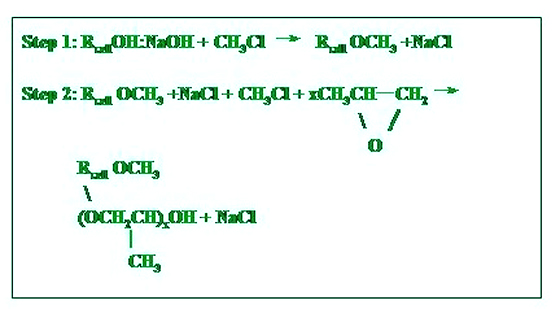| HPMC (Hypromellose) |
|
1: What is HPMC
(Propylene
glycol ether of methylcellulose) Hydroxypropyl methylcellulose is a methylcellulose modified with a small amount of propylene glycol ether groups attached to the anhydroglucose of the cellulose. The dry product contains 19 to 30 per cent of methoxyl (-OCH3) groups and 3 to 12 per cent. of hydroxypropyl (-OCH2CHOHCH3) groups.HPMC can be derived from tree fiber or cotton fiber. |
|
2: How
HPMC is made The cellulose ethers are manufactured by a reaction of purified cellulose with alkylating reagents (methyl chloride) in presence of a base, typically sodium hydroxide and an inert diluent. The addition of the base in combination with water activates the cellulose matrix by disrupting the crystalline structure and increasing the access for the alkylating agent and promotes the etherification reaction. This activated matrix is called alkali cellulose (Kirk-Othmer, 1993). During the manufacture of HPMC alkali cellulose reacts with methyl chloride to produce methyl cellulose and sodium chloride. Side reactions of the methyl chloride and sodium hydroxide produce methanol and dimethyl ether by-products. The methylcellulose is then further reacted with the staged addition of an alkylene oxide, which in the case of HPMC is propylene oxide (Kirk Othmer, 1993; Dow, 2002).After this reaction, MC and HPMC are purified in hot water, where they are insoluble. Drying and grinding completes the process. |
|
3:
Chemicals agents and reactions The chemical reactions of manufacturing HPMC summarized as following: |
 |
|
Methyl chloride (CH3Cl) is colorless gas with a faint, sweet odor
that is not noticeable at dangerous concentrations. Synthetic forms
are a chlorinated hydrocarbon derived from petroleum, and a
suspected carcinogen. (Lewis, 1992; NJ1998). Propylene oxide is also a petroleum derivative. |
|
4: Environmental concerns EPA – Clean Air Act Amendments – Hazardous Air Pollutants includes Methyl Chlorides and Propylene oxide, two chemicals used in production of HPMC.(FR67:112: 40044) June 11, 2002. |
|
5: Further reading Following are some recommended further reading about HPMC: 1) FDA GRAS Notice (releasable information): 213, link to the pdf file. 2) NOSB TAP Review Compiled by OMRI- Hydroxypropyl Methylcellulose. Link to USDA sites pdf file. 3) American Association of Pharmaceutical Scientists 2014 P. Timmins et al. (eds.). Hydrophilic Matrix Tablets for Oral Controlled Release; AAPS Advances in the Pharmaceutical Sciences Series 16, DOI 10.1007/978-1-4939-1519-4_2 4) P. L. Nasatto et al. Methylcellulose, a Cellulose Derivative with Original Physical Properties and Extended Applications; Polymers 2015, 7, 777-803 |
